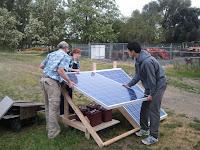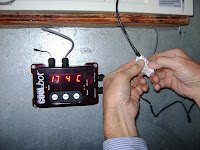 |
| CoolBot group members Mike and Daniel with faculty collaborator and D-Lab instructor |
 |
| Mike Cunningham working on inverter |
In collaboration with Horticulture Collaborative Research Support Program (Hort CRSP), the D-Lab CoolBot group set about assembling a model standalone photovoltaic array in order to power the demonstrative CoolBot Coolroom at the UC Davis Student Farm.
 |
| Ariana and Mike assembling solar array with faculty collaborator |
 |
| CoolBot group installs solar array |
Ariana, Sheeter and Mike all helped assemble and successfully connect the photovoltaic array to the CoolBot Coolroom on April 18th and 19th, just in time for a visit from the touring Hort CRSP conference!
--
Ariana Rundquist, D-Lab Student
Ariana Rundquist, D-Lab Student
International Agricultural Development
Graduate Group
University of California in Davis
University of California in Davis







